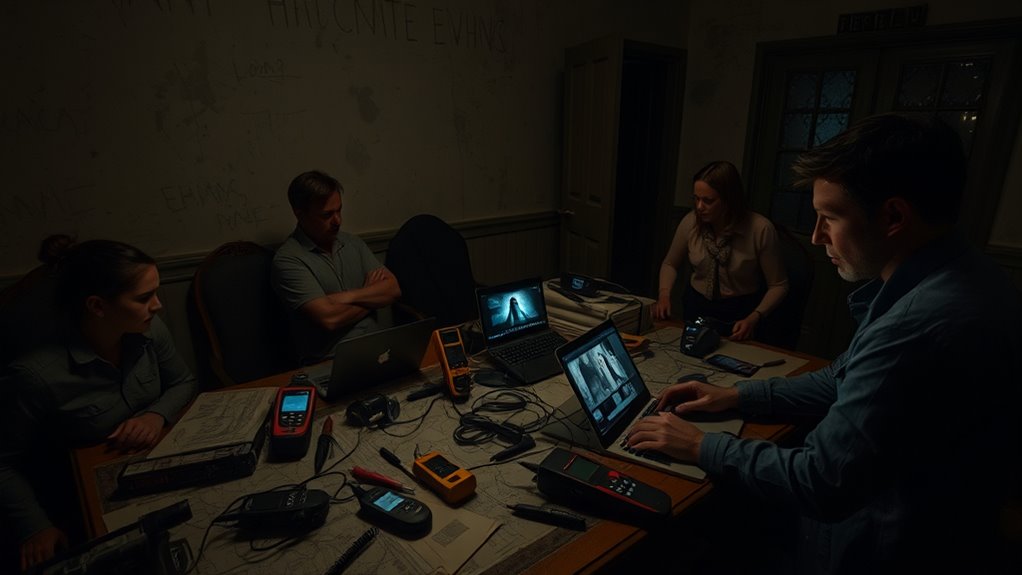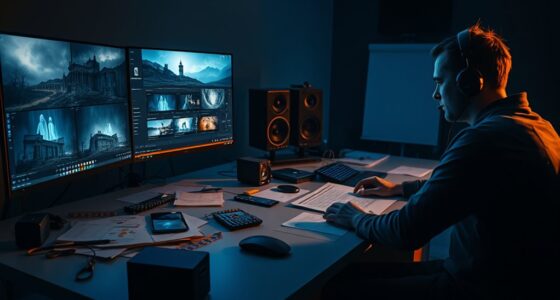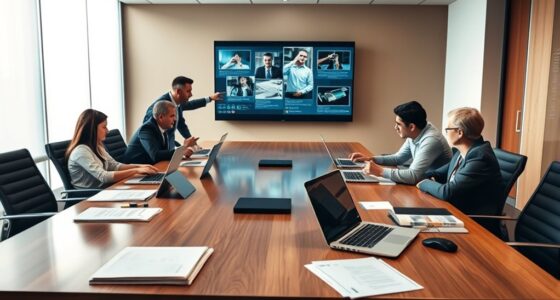In a paranormal investigation, you start by assembling a diverse team and defining clear goals. You research the location thoroughly, checking its history and gaining permissions. Next, you set up equipment like cameras and sensors to establish a baseline. During the session, you actively monitor for anomalies and document everything carefully. Afterward, you analyze all evidence, considering natural explanations. Reflecting on the experience helps improve future efforts; if you keep exploring, you’ll uncover even more insights.
Key Takeaways
- Proper planning involves site research, defining investigation goals, and assembling a skilled, coordinated team.
- Equipment deployment requires strategic placement and environmental baseline recordings to ensure accurate data collection.
- Active monitoring includes observing environmental changes, documenting anomalies, and responding systematically to phenomena.
- Evidence analysis focuses on verifying credibility, identifying patterns, and ruling out natural causes or malfunctions.
- Post-investigation involves detailed reporting, safety reviews, team debriefs, and refining methods for future investigations.
Assembling the Team and Establishing Objectives
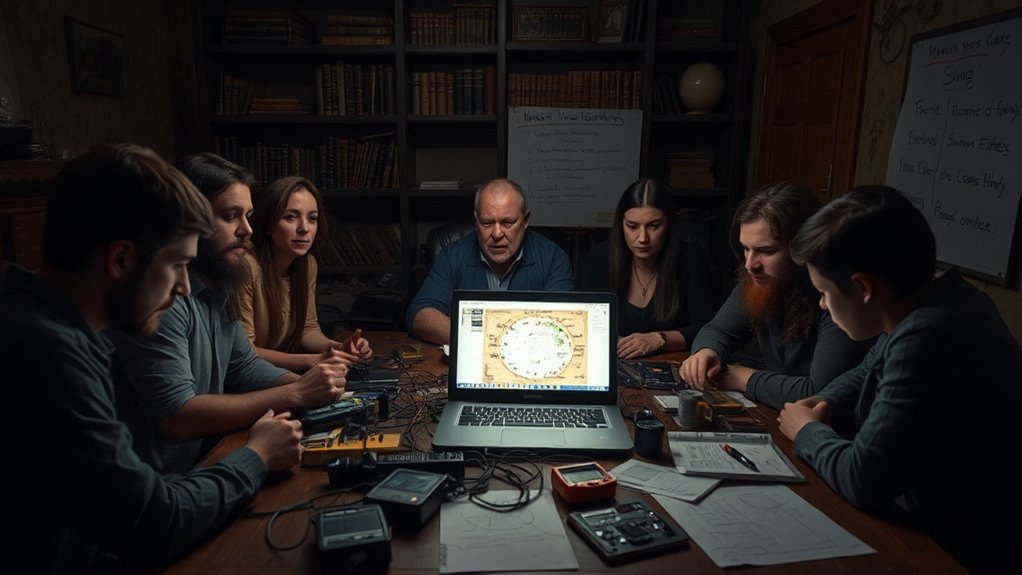
Before beginning a paranormal investigation, you need to assemble a capable team and clearly define your objectives. Choose team members with diverse skills—such as experienced investigators, tech experts, or those with a background in the paranormal. Make sure everyone understands their roles and responsibilities from the start. Setting clear objectives is essential; decide whether you’re seeking evidence of paranormal activity, trying to identify specific phenomena, or simply exploring the location. Communicate your goals to the team so everyone stays focused. This preparation helps prevent confusion during the investigation and ensures that your efforts are coordinated and efficient. A well-organized team with defined objectives lays the foundation for a successful and productive investigation. Incorporating best practices from successful investigations can greatly enhance your chances of obtaining credible evidence.
Selecting the Location and Conducting Preliminary Research
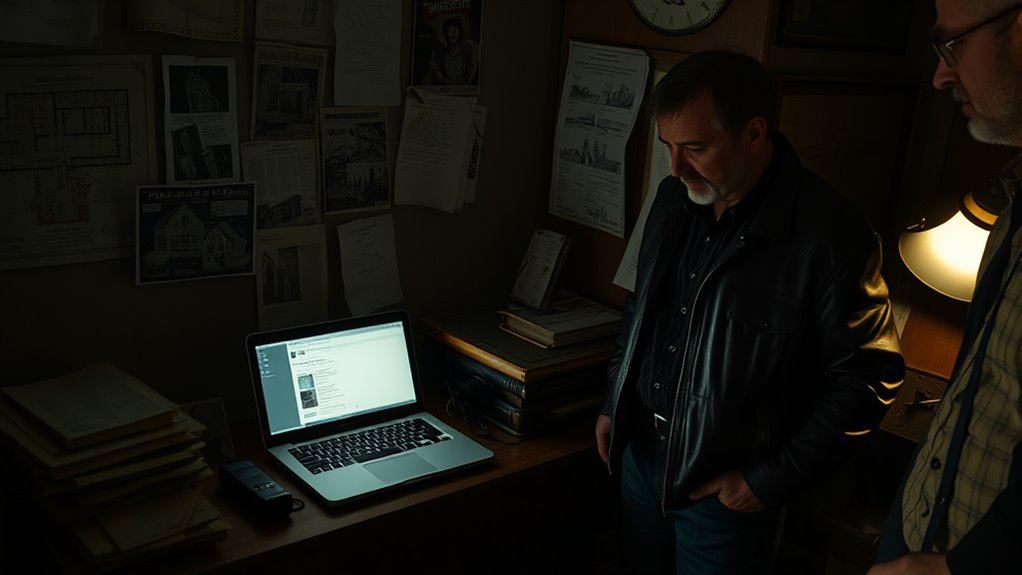
Choosing the right location sets the stage for a successful investigation. You want a site with a reputation for paranormal activity or documented history. Research the location’s background, including past events, local legends, or reported sightings. Visit online forums, local archives, or talk to residents to gather insights. This community knowledge can reveal common paranormal phenomena that may occur in the area. Confirm access permissions and safety considerations before proceeding. Preliminary research also involves studying the layout, noting areas of interest, and identifying potential sources of interference or noise. By thoroughly understanding your chosen site beforehand, you increase your chances of capturing meaningful evidence and reduce surprises during the investigation. This groundwork ensures your efforts are focused and informed, setting a solid foundation for the entire process.
Setting Up Equipment and Creating a Baseline

When setting up your equipment, focus on strategic placement to cover all key areas without interference. Make sure to record environmental conditions like temperature, humidity, and ambient noise before starting. Establishing these baseline readings helps you identify normal patterns and spot anomalies during your investigation. Paying attention to image quality factors can also enhance the clarity and effectiveness of your recordings.
Equipment Placement Strategies
Establishing effective equipment placement begins with understanding the environment and identifying key areas where activity is most likely to occur. You want to position your devices to maximize coverage and sensitivity without interfering with natural movement. Consider these strategies:
- Place cameras at angles that cover multiple zones, avoiding blind spots.
- Position EVP recorders near suspected activity spots, but away from noise sources.
- Set motion detectors where movement is expected or where activity has been reported.
- Keep environmental sensors in areas prone to temperature or humidity changes, but outside direct airflow or drafts.
- Regularly monitor and adjust your setup to ensure optimal equipment placement and sensitivity based on ongoing observations.
Recording Environment Conditions
Before starting your investigation, establishing your equipment correctly and establishing a baseline of environmental conditions is essential. Begin by setting up your devices in strategic locations, ensuring they’re stable and functioning properly. Use your thermometer, humidity meter, and light sensors to record initial readings, noting temperature, humidity, airflow, and ambient light levels. Keep detailed notes on these conditions, as they provide a reference point for later analysis. Make sure all equipment is functioning without interference, and verify that power sources are stable. Avoid adjusting anything during this phase; focus on capturing an accurate snapshot of the environment. This baseline helps you distinguish between normal environmental fluctuations and potential paranormal activity during your investigation. Additionally, ensure your audio recording devices, such as your headphones(1st Home Theatre Projector), are properly paired and tested to capture clear sound without interference.
Establishing Baseline Readings
Setting up your equipment properly is the first step toward a successful investigation. To establish accurate baseline readings, you need to familiarize yourself with the environment’s normal conditions. This helps you distinguish natural fluctuations from potential paranormal activity. Here’s what to do:
- Turn on all devices and allow them to stabilize before recording data.
- Record ambient temperature and humidity levels.
- Check for background electromagnetic interference.
- Note any usual sounds or environmental factors.
- Regular maintenance and proper placement of your equipment are crucial for effective air quality monitoring, ensuring that readings are accurate and reliable.
Engaging With the Environment and Collecting Data
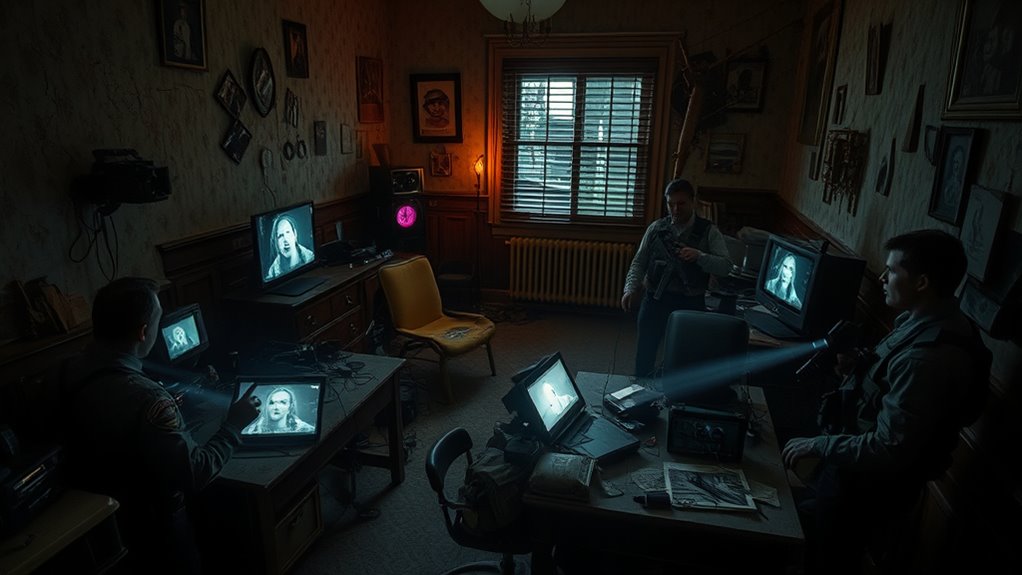
To effectively engage with the environment during a paranormal investigation, you need to actively observe your surroundings and be ready to collect data at any moment. Stay attentive to subtle changes in temperature, light, or sounds, as these can indicate activity. Use your equipment carefully, positioning cameras, EMF meters, and audio recorders strategically to capture potential anomalies. Keep a detailed journal to note your impressions, environmental conditions, and any unusual occurrences. Move slowly and deliberately, avoiding unnecessary disturbances that could interfere with data collection. Trust your senses—sometimes a faint smell or a sudden shift in atmosphere can be significant. Being alert and prepared allows you to seize opportunities for valuable insights, ensuring you don’t miss critical pieces of evidence. Additionally, understanding the power output of devices like electric dirt bikes can help you gauge energy levels in a location, which might be useful when assessing paranormal activity.
Monitoring, Recording, and Responding to Anomalies

Monitoring, recording, and responding to anomalies requires you to stay vigilant and ready to act whenever unexpected activity occurs. Your focus should be on capturing data accurately and reacting swiftly to potential phenomena. Use various tools like:
- Audio recorders to capture unexplained sounds
- Video cameras to document visual anomalies
- EMF meters to detect electromagnetic disturbances
- Personal notes to record your immediate impressions and reactions
Stay alert for sudden changes or unusual activity, and be prepared to investigate further without jumping to conclusions. Respond calmly and methodically, ensuring your equipment remains operational and your observations precise. Quick, clear documentation is essential, as your responses could influence the investigation’s overall findings. Remember, vigilance and prompt action are key to capturing meaningful evidence. Additionally, understanding Glycolic Acid benefits can help in maintaining healthy skin, which is important when conducting investigations that may involve physical exposure or skin sensitivities.
Analyzing Evidence and Interpreting Findings

When analyzing evidence, you need effective categorization techniques to organize your findings accurately. It’s crucial to differentiate between natural explanations and genuine paranormal activity to avoid misinterpretation. Proper reporting and documentation ensure your investigation results are clear, credible, and ready for review. Additionally, implementing safety checklists and seasonal prep routines can help maintain a secure environment during your investigations.
Evidence Categorization Techniques
Effective evidence categorization begins with analyzing the data systematically to distinguish credible signs from ambiguous or misleading impressions. You want to avoid jumping to conclusions and instead focus on clear criteria. Start by sorting evidence into categories such as physical phenomena, electronic anomalies, auditory signals, and visual impressions. Then, evaluate each piece for consistency, repeatability, and context. Consider how environmental factors or equipment malfunctions might influence the data. To streamline this process, check for:
- Correlation with known natural causes
- Presence of corroborating evidence
- Anomalies that defy logical explanation
- Patterns or recurring signals
- Supermarket hours can impact the timing and scheduling of investigations, especially during holidays or special events.
Differentiating Natural Versus Paranormal
To accurately distinguish between natural causes and genuine paranormal phenomena, you need to critically analyze the evidence within its context. Consider environmental factors, such as drafts, electrical interference, or animal activity, which can create misleading sensations or sounds. Evaluate the timing and consistency of the evidence—does it occur during specific conditions or repeatedly? Look for natural explanations before jumping to paranormal conclusions. Cross-reference findings with historical or situational details; sometimes, what seems unusual is explainable by known phenomena. Trust your logical assessment and remain objective. Avoid confirmation bias by questioning initial impressions. Remember, genuine paranormal activity often defies natural explanations, but thorough contextual analysis helps you avoid false positives and ensures your conclusions are well-founded.
Reporting and Documentation Strategies
Accurate reporting and thorough documentation are essential for analyzing paranormal evidence effectively. You need a clear record of every detail, from timestamps to environmental conditions, to interpret findings precisely. Proper documentation ensures your data is reliable and reproducible. When analyzing evidence, focus on objectivity and consistency. Use these strategies:
- Record detailed descriptions of each piece of evidence, including date, time, and location
- Photograph or video evidence, noting angles and conditions
- Log environmental factors like temperature, humidity, and electromagnetic activity
- Cross-reference findings with witness statements and prior reports
Debriefing, Reporting, and Reflecting on the Experience
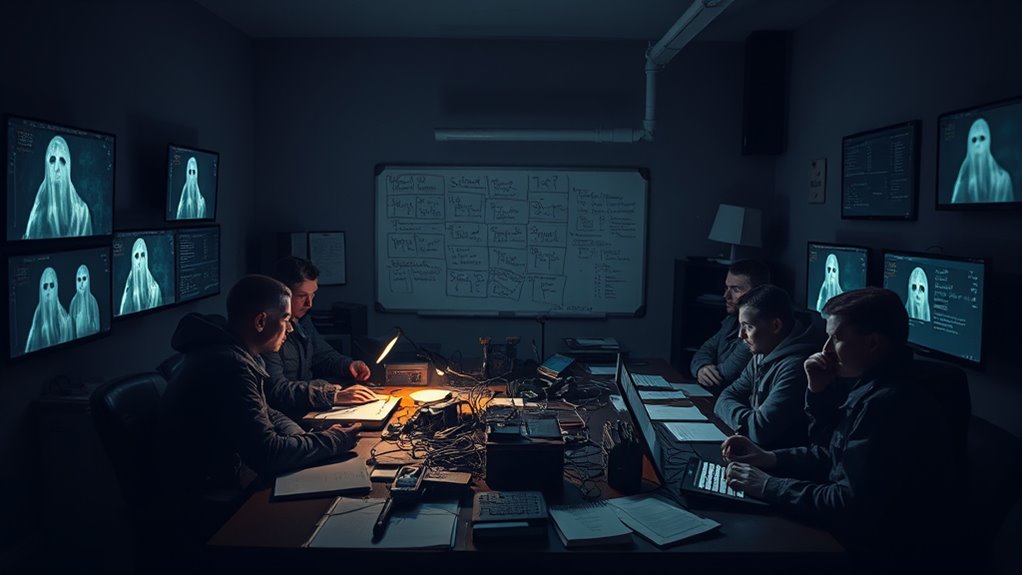
After a paranormal investigation, debriefing, reporting, and reflecting on the experience are essential steps that help you understand what occurred and identify any patterns or anomalies. During debriefing, gather your team to discuss observations, evidence, and any unexpected events. Review your documentation thoroughly, noting discrepancies or new insights. When reporting, compile clear, detailed accounts of your findings, emphasizing credible evidence and noting potential explanations. Reflect on the investigation’s success and areas for improvement. Consider what evidence supports paranormal activity and what might be natural causes. This process not only solidifies your understanding but also enhances your skills for future investigations. Effective debriefing and reflection ensure you learn from each experience, helping you refine your approach and better interpret your findings.
Frequently Asked Questions
How Do Investigators Handle False Alarms During Investigations?
When you encounter false alarms during investigations, you stay calm and methodically review your equipment and data. You verify suspicious readings by cross-checking with other devices and re-evaluating the environment. If needed, you isolate the source to determine if it’s natural or man-made. You document everything thoroughly, learn from the incident, and adjust your procedures to prevent similar false alarms in future investigations.
What Ethical Considerations Are Involved in Paranormal Research?
You should prioritize honesty, respect, and transparency in paranormal research. Always obtain consent from those involved, avoid sensationalism, and clearly communicate your findings without exaggeration. Respect the beliefs and privacy of others, and avoid manipulating or fabricating evidence. Maintaining integrity not only upholds ethical standards but also fosters trust within the community, ensuring your investigations are credible and respectful of all parties involved.
How Do Teams Ensure Safety During Potentially Dangerous Encounters?
Think of safety gear as your armor in a battlefield; it’s essential. You wear protective equipment, stay aware of your surroundings, and follow strict protocols. For example, a team member once avoided injury by recognizing unstable structures early. Regular communication, backup plans, and respecting boundaries keep you safe. Trust your training and instincts, and never underestimate the potential risks—preparedness is your best defense in dangerous encounters.
What Legal Permissions Are Required to Investigate Private Properties?
You need to obtain written permission from the property owner before investigating private properties. Always have a signed release form that clearly states your intent and limits liability. Check local laws, as some areas require permits or notifications. Respect privacy and boundaries, and make certain you have the owner’s contact information for emergencies. Getting proper consent not only keeps you safe legally but also fosters trust and cooperation.
How Is Team Credibility Maintained in the Paranormal Community?
You maintain team credibility by consistently demonstrating professionalism, honesty, and respect for clients’ privacy. Always verify your evidence thoroughly and avoid sensationalism, which can damage your reputation. Share transparent, detailed reports and welcome peer reviews to build trust within the community. Building relationships with other investigators and staying current with scientific methods also enhance your credibility, proving you’re committed to genuine investigation rather than sensationalism.
Conclusion
As you close the door on your investigation, remember that every ghostly whisper and flickering shadow is just a piece of the puzzle. Like a seasoned detective piecing together clues, your journey into the paranormal is a dance between science and mystery. Embrace the unknown with curiosity and caution, for in this haunted symphony, you’re both the investigator and the storyteller, weaving tales from the shadows that linger just beyond the veil.
